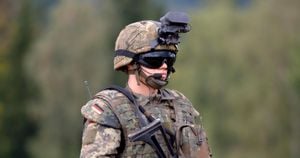Efforts to map the depths of the Great Lakes are gaining momentum, led by the Great Lakes Observing System, as they push to create detailed maps of the lakes' bottoms. This ambitious initiative aims to locate countless underwater shipwrecks, reveal hitherto invisible topographical features, and identify important infrastructure beneath the waters. Jennifer Boehme, the executive director of the organization, envisions these maps assisting ships by helping to avoid submerged hazards, supporting fisheries management, and improving models for erosion, storm surges, and flooding as climate change continues to escalate.
Boehme, who spent her childhood gathering treasures at beaches in St. Petersburg, Florida, now looks to replicate her youthful explorations, but instead of sand dollars and shells, she seeks to unearth knowledge from the hidden depths of the Great Lakes. "There's a lot we don't know about the lakes. We know more about the surface of the moon," Boehme stated, shedding light on the surprising lack of detailed mapping of these vast water bodies.
Despite having only mapped about 15% of the lakes' floor using low-resolution technologies decades ago, the Great Lakes Observing System has been authorized by the National Oceanic and Atmospheric Administration (NOAA) since 2016 to manage federal data effectively. Since then, they have been advocating for high-resolution mapping to cover all five Great Lakes, facing the monumental task of charting 94,250 square miles – bigger than Kansas!
The mapping project has gained new life as advances in technology have allowed scientists to generate accurate maps of coastlines, exemplified by recent high-resolution mapping completed for Florida’s shore and the Gulf of Mexico over the past three years. Demonstrably invested, U.S. Congress representatives from Michigan, Lisa McClain, and Debbie Dingell have introduced legislation proposing $200 million be allocated for the mapping project by the year 2030. Yet, Boehme is cautious as she recognizes the challenges of progressing through the political maze during an election year.
Reflecting on past efforts, it has been nearly 50 years since the last major mapping initiative, which utilized single-beam sonar technology. This outdated method produced limited, low-resolution maps, missing key underwater features like shipwrecks, pipelines, and sand dunes. The advancements now available include multifaceted technologies such as multibeam sonar, capable of sending hundreds of sound waves to the lakebed simultaneously, allowing for the detection of even the tiniest disturbances like air bubbles.
Among those advocating for the project is Steven Murawski, a biological oceanographer from the University of South Florida, who has extensive experience mapping coastlines. Murawski advocates for the necessity of these updated maps as they will significantly improve safe navigation and shipping operations, offering data on how underwater landscapes change due to erosion and shifting sand over time. The anticipated maps are expected to provide clarity on storm surges and flooding occurrences, which would be valuable to both insurance firms and city planners aiming to safeguard communities from climate-related disasters.
Importantly, the high-resolution mapping could also enumerate the thousands of shipwrecks speculated to exist under the lake's surface—estimates suggest there may be around 6,000. The discoveries could go beyond modern navigational needs, providing insights to historical relics and submerged ruins from ancient civilizations.
Despite all this excitement, the path to financial support hasn't been straightforward. There's been minimal action from Congress on the proposed legislation since the bill was introduced earlier this year during the House Natural Resources Subcommittee meeting, leading to observations within Congress pointing to the need for community advocates to clearly delineate the mapping's benefits beyond just historical interests. For example, Douglas Bentz, the subcommittee chair, urged supporters to make the case stronger than merely locating famous shipwrecks, emphasizing practicality and the modern-day benefits of accurate undersea maps.
With the legislative clock ticking, Boehme emphasizes the significance of persistence. The Great Lakes Observing System continues its march toward the 2030 goal of comprehensive mapping. They hold annual conferences, including one planned for Traverse City, Michigan, where technologies can be tested and community involvement encouraged. The excitement surrounding this extensive mapping project continues to build as both professional and local communities recognize the potential benefits of truly knowing the Great Lakes from the ground up.



